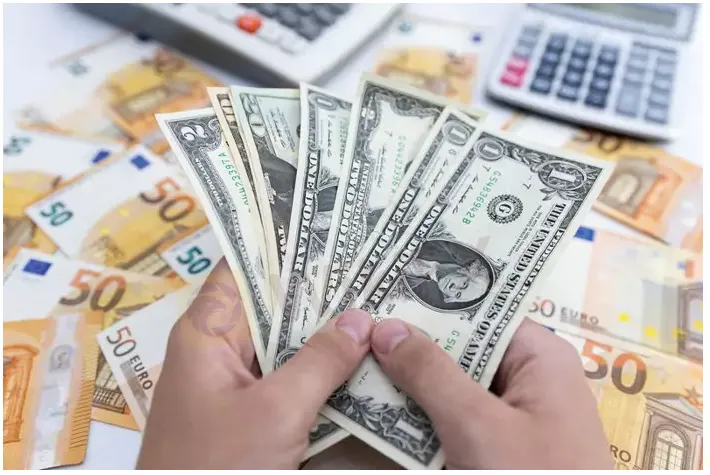简体中文
繁體中文
English
Pусский
日本語
ภาษาไทย
Tiếng Việt
Bahasa Indonesia
Español
हिन्दी
Filippiiniläinen
Français
Deutsch
Português
Türkçe
한국어
العربية
Euro under pressure as inflation fears send investors to dollar haven
Abstract: The euro struggled to regain a footing on Thursday, having tumbled overnight against a resurgent U.S. dollar, which benefited from safe-haven demand on renewed worries about higher rates and a global recession.

SINGAPORE/HONG KONG (Reuters) – The euro struggled to regain a footing on Thursday, having tumbled overnight against a resurgent U.S. dollar, which benefited from safe-haven demand on renewed worries about higher rates and a global recession.
The euro was at $1.044, after losing 0.75% on the dollar the day before, and heading for a monthly decline of 2.7%.
It also dropped to a fresh 7-1/2-year low versus the Swiss franc at 0.99663 francs, with the Alpine currency another beneficiary of safe-haven flows and also still basking in the afterglow of the Swiss National Banks surprise rate hike two weeks ago.
Christopher Wong, senior FX strategist at Maybank, attributed the euros fall against the dollar to the market moving away from riskier assets after “central bankers warned of lasting inflation and that they would prioritise combating (it), resulting in broad dollar rebound overnight.”
A steady and aggressive global switch to tighter policy has stoked recession worries and shaken financial markets in recent months.
Speaking at the European Central Banks annual conference in Sintra, Portugal, U.S. Federal Reserve Chair Jerome Powell said it was important to bring down inflation, even if it meant economic pain, with similar remarks from ECB President Christine Lagarde.
Lower German inflation figures also briefly weighed on the euro, said Ray Attrill head of FX strategy at National Australia Bank, before “the market realised that there was some special factors there, it wasnt a genuine downside surprise.”
“The bigger picture worry is what happens with energy supplies in the eurozone as we head towards the winter… Were quite cautious about the euro,” Attrill added.
The dollar was also on the front foot against other majors, with sterling hunkered down at $1.21225, with losses this week leaving it set for a 3.8% monthly decline, while the Australian dollar was struggling at $0.6873.
The dollar also hit fresh a 24-year peak of 137 yen overnight, as the gap between a hawkish Fed and a dovish Bank of Japan continues to weigh heavily on the yen, which was last trading at 136.57 yen.
The BOJ is able to keep interest rates pinned down because Japanese inflation is still low by global standards, though even small price rises are causing a messaging problem for the central bank.
The dollar index, which measures the greenback against six peers, was at 105.19, a two week high.
Bitcoin, dipped back below the symbolic $20,000 level on persistent market ructions, and was also hurt by the U.S. Securities and Exchange rejecting a proposal to list a spot bitcoin exchange-traded fund by Grayscale, one of the worlds biggest digital asset managers.

Disclaimer:
The views in this article only represent the author's personal views, and do not constitute investment advice on this platform. This platform does not guarantee the accuracy, completeness and timeliness of the information in the article, and will not be liable for any loss caused by the use of or reliance on the information in the article.
Read more

Bank Negara Malaysia Flags 12 New Companies for Unauthorised Activity
Bank Negara Malaysia (BNM) has updated its Financial Consumer Alert List (FCA List) by adding 12 more entities, reinforcing its efforts to warn the public against unregulated financial schemes. Check if your broker made the list!

TradingView Brings Live Market Charts to Telegram Users with New Mini App
TradingView has launched a mini app on Telegram, making it easier for users to track market trends, check price movements, and share charts.

March Oil Production Declines: How Is the Market Reacting?
Oil production cuts in March are reshaping the market. Traders are closely watching OPEC+ decisions and supply disruptions, which could impact prices and future production strategies.

How to Calculate Leverage and Margin in the Forex Market
Leverage amplifies both potential profits and risks. Understanding how to calculate leverage and margin helps traders manage risks and avoid forced liquidation.
WikiFX Broker
Latest News
The Withdrawal Trap: How Scam Brokers Lure Victims into Paying More
FCA to Investors: Think Twice Before Trusting These Brokers
Trump\s tariffs: How could they affect the UK and your money
Trump gambles it all on global tariffs he\s wanted for decades
TradingView Brings Live Market Charts to Telegram Users with New Mini App
Trump tariffs: How will India navigate a world on the brink of a trade war?
IG Group Acquires Freetrade for £160M to Expand UK Investment Market
U.S. March ISM Manufacturing PMI Released
Should You Beware of Forex Trading Gurus?
Vanuatu Passes VASP Act to Regulate Crypto and Digital Assets
Currency Calculator







